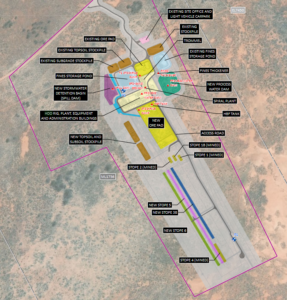Balranald is a rutile-rich deposit in the northern Murray Basin of New South Wales, Australia. With deposits located approximately 60 m below the surface, Iluka is assessing the potential to develop these using a novel, internally developed, underground mining technology. Worley says its teams in Australia and Kolkata will provide engineering management and resources to develop the design, estimate and execution plan for the process plant and associated infrastructure.
“Worley has over 50 years of experience designing and executing mining projects from concept to operations. Working with Iluka, we’ll approach the DFS with construction in mind to prepare for a successful operation. We thank Iluka for the award and look forward to a positive outcome.” said Gillian Cagney, Regional Managing Director, Australia & New Zealand.
Iluka has already undertaken a third technology trial (T3) completed in late 2020 to determine whether the technology is economically viable. The trial confirmed the effectiveness of the underground mining method and validated key elements of the mining unit design, such as materials of construction that have thwarted previous attempts to mine for extended periods of time. Site construction began in September 2019 ahead of an underground mining system trial from June to October 2020. Site works were completed and demobilised by the end of November 2020.

In more detail, mining commenced in June 2020 with the development and mining of a new stope (Stope 6) and the re-entry and additional mining of Stope 4. The trial removed 30,900 t of material during mining with the ore processed on-site to produce 11,900 t of heavy mineral concentrate (HMC). The trial backfilled
approximately 1,540 t of sand and clay tailings to the mining zone. Approximately 2,766 t was used to rehabilitate the subsidence holes created as the result of operations.
Development of Stope 6 commenced using a HDD rig to create declines. The stope development process includes drilling a pilot hole, enlarging the hole and installing casing. Following development of Stope 6, the HDD rig was moved to recondition the previous developed Stope 4. The mining sequence is as follows: directional drilling/casing of access holes through the overburden to the ore zone; horizontal borehole drilling with drill strings advanced along the decline and into the orebody; high pressure water used to fluidise the ore; eductor pumping of slurried ore to the surface, which creates stopes within the orebody.
Then a process plant is used to screen and separate fines and oversize material, including a trommel, thickener and spiral plant. There is temporary stockpiling of the mineral ore for metallurgical and geochemical test work and reinjection of the separated coarse material and fines as a hydraulic backfill (mixed slurry) into the mined-out stopes. The backfill material contains a mixture of sand and slimes once the Heavy Mineral (HM) has been removed.










